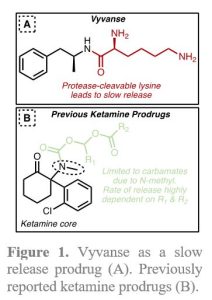About the Seminar
Ketamine has become a promising new therapeutic for treatment-resistant major depression. However, the transient nature of ketamine’s anti-depressive activity reduces its current viability as a treatment. Additionally, since the drug has such a high incidence of abuse, receiving treatment is challenging for patients. The drug Vyvanse is a prime example of how medicinal chemists have addressed many of the issues that ketamine also faces. By attaching a lysine amino acid residue to Adderall, Vyvanse is slowly metabolized into Adderall by proteases in the blood (Figure 1A). This lowers the ability for the drug to be abused and eliminates the need for multiple doses throughout the day. Ketamine also has an amine that could be used to make a prodrug. Previous reports in the patent literature have utilized (acyloxy)alkyl carbamate ketamine prodrugs in the hopes of achieving a slow release similar to Vyvanse (Figure 1B). However, while these prodrugs do display an increase in bioavailability (Cmax), they do not have any significant extended-release characteristics (Tmax and T1/2 roughly equal for prodrugs and ketamine). To address the current limitations, this proposal will focus on the ketamine metabolite norketamine as a scaffold for prodrug design.




